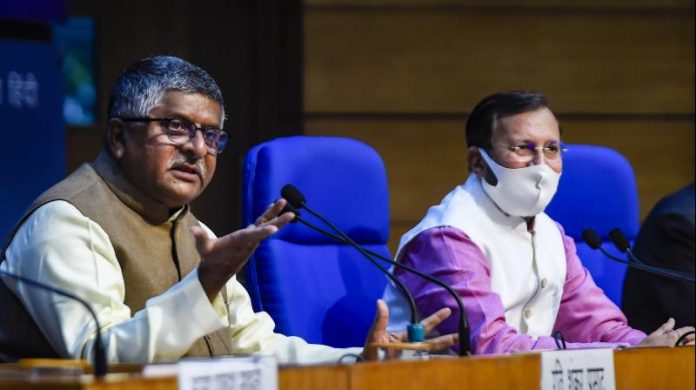Announcing new rules for social media companies and a code of ethics for OTT streaming platforms and digital news media, Union ministers Ravi Shankar Prasad (left in pic) and Prakash Javadekar, on 25th February said that they “are empowering the ordinary users of social media” and aiming to address “double standards” by platforms on moderating content. This is the first time ever that OTT platforms, and digital news media have been brought under regulation in the country. Social media giants like Facebook, WhatsApp, Twitter, Instagram, Facebook and Google are all covered by the new guidelines. The 30-page document, titled Information Technology (Guidelines for Intermediaries and Digital Media Ethics Code) Rules, 2021, define social media companies, and suggest a three-tier mechanism for regulation of all online media, which confers blocking powers to an inter-ministerial committee. Describing the rules as a “soft touch mechanism”, Union Electronics & IT Minister Ravi Shankar Prasad said, they will be implemented in three months’ time. The big social media platforms will have to give information on source of unlawful and inflammatory messaging within 72 hours. They will have to be prompt in responding to requests of users, especially women, on removal of objectionable content such as nudity or sexual acts. The time limit for taking down “unlawful” content has been set at 36 hours.
Platforms like Netflix, Amazon Prime Video and Disney+ Hotstar will have to provide age-related classifications, as per the new rules. The content will be divided into five categories:
(1) suitable for universal viewing (U),
(2) for ages 7 and above (UA 7+),
(3) for ages 13 and above (UA 13+),
(4) for ages 16 and above (UA 16+), and
(5) adult (A).
The content classification will also identify content on the basis of themes and message, violence, nudity, sex, language, drug and substance abuse, and horror.
The rules have come amidst major concerns of censorship and criticism of the process of rule making. Digital rights activists and experts have raised concern about the requirement by messaging platforms to trace the first originator of a message that may end up weakening end-to-end encryption.
A movement to regulate social media and OTT platforms had started months back but it gained momentum earlier this month. The government and Twitter had major differences related to content moderation, as the microblogging platform initially pushed back against the Union Electronics & IT Ministry’s order to block over 1,500 accounts related to the ongoing farmers’ protest. Similarly, OTT platforms like Netflix and Amazon Prime Video have also come under fire for airing content that, some claimed, “hurt religious sentiments”. Web series Tandav and Mirzapur are the latest examples.
“Social media is welcome to do business in India. They have done exceedingly well. They have got a good number of users. They have also empowered Indians. We commend this,” Prasad stated at the press conference on 25th to announce the restrictions.
Under Section 79 of the IT Act, social media platforms are classified as “intermediaries” and are protected from liability for content posted on their platforms by users. This provision, known as ‘safe harbour’, will apply to them now, only if they comply with due diligence requirements set out in the new rules. The rules prescribe due diligence that must be followed by intermediaries, including social media intermediaries. In case due diligence is not followed by the intermediary, safe harbour provisions will not apply to them, the government press release states. Intermediaries will be required to remove within 24 hours of receipt of complaints of content that exposes the private areas of individuals, shows such individuals in full or partial nudity or in sexual act, or is in the nature of impersonation including morphed images.
The additional obligations on the siginificant social media platforms will include the appointment of a chief compliance officer residing in India; a nodal contact person, grievance redressal officer, and the requirement to publish a monthly compliance report.
The rules contain a three-tier regulatory mechanism:
The first tier of the regulatory mechanism is grievance redressal by the company itself.
The second tier involves a Press Council of India-like regulatory body that will be headed by a retired judge of a high court or the Supreme Court.
The third tier will comprise an inter-ministerial committee and will be headed by a joint secretary-level officer from the I & B ministry. In effect, in addition to the IT ministry, this committee would also recommend blocks or take-downs, the report states.
The rules also contain a ‘Code of Ethics’, which prescribe the guidelines to be followed by OTT platforms and online news and digital media entities.
Encouraging “self regulation” by digital media and streaming platforms, the ministers said that they shall appoint a Grievance Redressal Officer, based in India, who shall be responsible for the redressal of grievances received by it. The officer shall take a decision on every grievance received by it within 15 days.






























